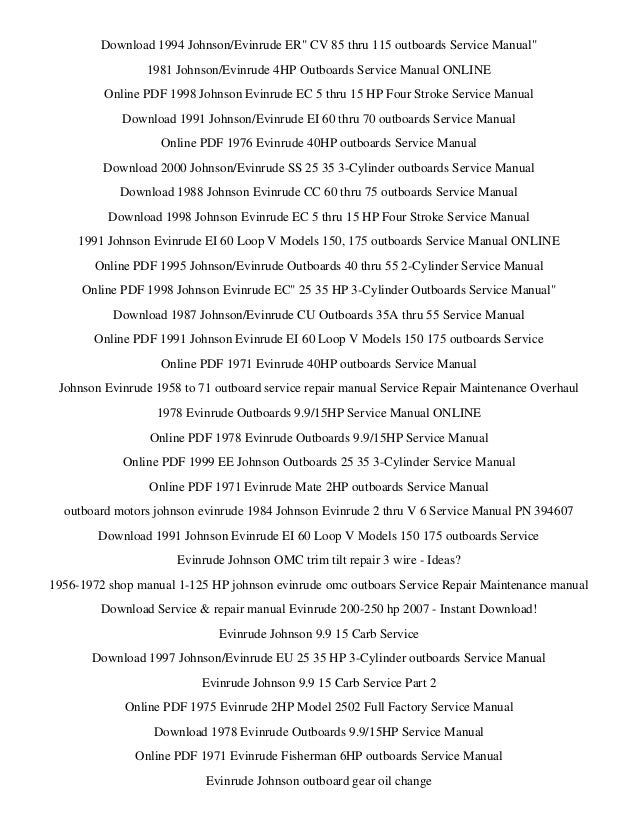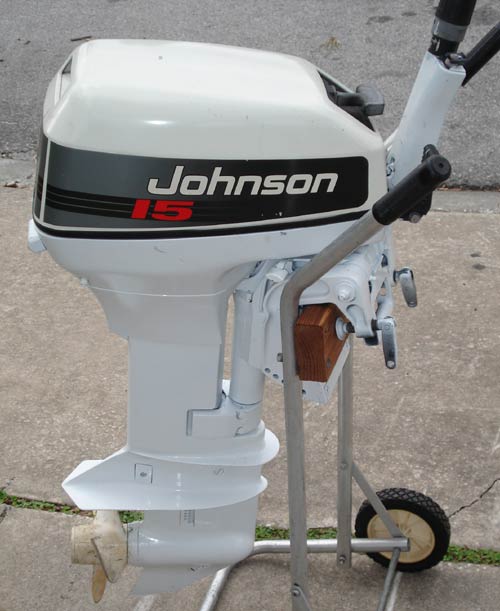Johnson 15hp 2 Stroke Service Manual

Edited by Bill Grannis 1) What is my fuel/oil ratio? Johnson and Evinrude carbureted 2-stroke outboards since 1964 require a 50:1 fuel to oil mixture (2%) on engines without an automatic oiling system – 6 gallons of gas to 1 pint of outboard oil. Refer to question #5 for information on oil. Most outboards manufactured before 1964 need 24:1. Fishing motors prior to 1955 commonly used a 16:1 ratio.
2 Stroke Oil
Refer to question #20 for more information about older outboards. 2) How can I tell my model year? Every modern outboard has a model and serial number tag or plate on the front of the motor between the transom brackets or on the side of the transom bracket. Very old motors have the numbers stamped into the flywheel or on the cylinder block. You can download a model-year guide at: 3) What is my sparkplug gap? Refer to question 4. 4) What is the correct sparkplug for my engine?
The proper sparkplugs and the correct gap specifications are found in your Operator’s Guide, the service manual, or in the dealer’s Parts & Accessory Catalog. If the engine is 1998 or newer, you can consult the EPA Emissions Control Label near the model and serial number tag for sparkplug information. An online factory sparkplug chart can be accessed at, choose MAINTENANCE, then select SPARKPLUGS from the categories. Click on your type of outboard and scroll down to the appropriate engine listing. NOTE: a) Sparkplug cross-reference charts may not be accurate. Use only the factory recommended sparkplugs for your motor to avoid engine problems and to comply with EPA emission regulations. B) Sparkplug recommendations may have changed over the years compared to what was printed in the original manuals.
Consult the latest Evinrude literature concerning updated sparkplug numbers for your engine. 5) What engine oil should I use? And what is the difference? Johnson and Evinrude two-stroke outboard engines perform best with Evinrude/Johnson Genuine Parts® XD-100, XD-50, or XD-30 oils which are specifically formulated for your motor. If Evinrude/Johnson Genuine Parts® oils are not available, you must use an NMMA® certified TC-W3® outboard motor oil. The XD-100 is synthetic oil, XD-50 utilizes a synthetic-blend formula, and XD-30 is conventional outboard oil.
XD-100 and XD-50 lubricants offer enhanced engine protection for FICHT, DI, and E-TEC models as well as for outboards operated in high-performance or heavy-duty applications. In addition, these two premium oils may reduce exhaust smoke when used in traditional outboard motors. NOTE: XD-100 is recommended for the operation of oil-injected outboards below 40°F (5°C) and is required for temperatures at or below freezing. Four-stroke Johnson and Evinrude outboards use Evinrude-Johnson Ultra 4-Stroke Oil® or an equivalent lubricant specified in the Operator’s Guide. For more oil information, go to: 6) Can I order parts directly from BRP? To find part numbers, prices, and to order parts: Go to, choose ONLINE STORE, click on PARTS.
Use the pull-down menu to choose which brand, then click on the year and the model number. Refer to question #2 to determine your engine’s model year. For ordering information: 7) What is the standard prop for my engine? Refer to question 8. 8) What type of propeller do I need? Only the 30 hp and smaller motors come equipped with a standard propeller. Because 40 hp and larger outboards are installed on all sizes and types of watercraft capable of various speeds, one propeller does not work on all boats.
Clymer Evinrude / Johnson Outboard Shop Manual: 2-300 HP Outboards. 2.0 HP, 2.3 HP, 3 HP, 3.3 HP, 4 HP, 4 HP Deluxe, 6 HP, 8 HP, 9.9 HP, 15 HP, 20 HP.
Proper engine operation and longevity are governed by the propeller. The general recommendation is to achieve an RPM in the upper half of the factory recommended operational range with a normal load aboard. It is up to the dealer or boat builder to furnish you with the correct prop for your boating needs.
Consult your dealer for more information on what propeller(s) would be recommended for your application. An Evinrude technical publication explaining how to find the correct propeller is available for download at: 9) What RPM should my engine run? Outboards have a recommended full throttle operational range that is listed in the Operator’s Guide and in the Service Manual. Typically, the best full-throttle RPM is in the upper half of the operational range and determined by the propeller. (Refer to question #8 for more information) The most advantageous cruising RPM and fuel economy are generally from 60% to 75% full-throttle depending on boat design, engine horsepower, load, and sea conditions. 10) What does my engine weigh? Refer to the Operator’s Guide, the appropriate service manual, or the specification page on the correct year’s sales brochure.
Weights are also listed in the NADA® pricing guide. 11) What gearcase oil do I need for my engine? Refer to your Operator’s Guide or the service manual. Over the years, oil types become outdated when improved lubricants replace them. Currently, all manual shift outboards can use the Evinrude/Johnson Genuine Parts® HPF-Pro gearcase lubricant.
Electric shift gearcases, from 1962 through 1972, require Type C or Premium Blend Gearcase Lubricant ®. Small non-shifting outboards, from the early 1950’s or older, may call for a #105 marine gear grease. 12) How much gearcase lube do I need? Refer to your Operator’s Guide or to the service manual for the exact capacity in fluid ounces. Generally speaking, 1 quart is more than enough for a small to medium sized outboard gearcase. For larger outboards, 2 quarts are ample and the remainder may be saved and used later. 13) What is the part number for the water pump kit of my engine?
You can look up the parts and prices at or contact your local dealer. Refer to question #6 for more details. 14) What is the correct battery capacity for my engine? Refer to your Operator’s Guide or to the service manual. This is one item where size does matter. Purchase the highest capacity battery you can afford as long as it EXCEEDS the minimum required specifications.
An 800 CCA (1000 MCA) group 24 battery should be adequate for any Johnson or Evinrude outboard. 15) How do I get service information for my engine? Evinrude stocks parts books, service manuals and operator’s guides for 1997 and newer products. 2016 honda outboards 50 hp manual. They may be ordered through your local dealer or from For 1996 and older models, contact: Ken Cook Company 9929 West Silver Spring Drive P.O. Box 250940 Milwaukee, Wisconsin53225 414-466-6060 16) I need a wiring diagram for my engine – do you have one? Wiring diagrams are printed in the factory service manuals.
Refer to question #15 on how to obtain a service manual. 17) Does the part I buy from BRP have a warranty? Standard parts come with a one year warranty. Certain assemblies, consumables, accessories, and specialized items may have a different warranty.
Consult your dealer for more information. Be aware that the parts warranty does not cover incorrect installation, wrong application, abuse, incorrect voltage, submerging, corrosion, modifications, or other conditions not related to a manufacturing defect. 18) What is in the 300 hour / 3 year service for my E-TEC? The 300 hour/ 3 year service interval is for normal recreational boating in fresh water. Salt water environments, high-performance applications, and commercial usage require more frequent service and inspections. Consult your dealer.
A maintenance guide illustrating most of the services needed for a 300 hour/ 3 year interval is published in the Operator’s Guide. A service manual is recommended as it goes into more detail of the servicing aspect. Contact your dealer who should be familiar with any additional services required that may be unique to your boating area or type of use. NOTE: For outboards beyond the original 3-year warranty and covered under the B.E.S.T. Extended service plan, proof of required 300 hour/3 year services by an authorized dealer is needed BEFORE commencing repairs.
19) Where did the purple wire go on the regulator you sold me? Originally the purple wire was required to sense the engine’s charging voltage. In 2002, the regulator was improved which eliminated the need for the purple wire. Be sure to secure and insulate the engine’s purple wire as it is not needed with the new style regulator.
20) I found an old outboard motor. What is it worth? Where can I find parts to get it running? Most older outboards only have a modest value since large numbers were built in the 1940’s, 1950’s, and 1960’s with many still in operation today. Certain models and engines manufactured prior to World War II are popular with collectors and enthusiasts.

Motors with visible damage, corrosion, or missing items have very little worth and are often purchased just for spare parts. For information about vintage motors and obsolete parts contact: Antique Outboard Motor Club P.O. Box 69 Sussex, WI 53089 262-367-6875.
Rules within the EU mean you can no longer buy a new, small 2-stroke outboard motor in Europe, but their light weight, compact size and longevity means tens of thousands of used examples are still to be found on boats from Caithness to Crete. The start of the season is when any unreliability issues are most likely to rear their ugly head, and there’s a good reason for that. ‘Most people assume they can just take their outboard off their boat and put it straight into their shed for the winter,’ technician Steve Dawkins told me in his workshop at the Cabin Boatyard on the Hamble River. ‘Then, come the spring, they’re surprised when it doesn’t work.’ I kept quiet. My outboard had been sitting forlornly in the garage among a pile of ropes, fenders and sails since it came ashore at the end of last summer. Do it yourself! This step-by-step guide takes you through a service of a small 2-stroke outboard.
The pictures show Mariner 3.3hp and Suzuki 2hp outboards, and while other makes of engine are subtly different, the main components should be recognisable. Anyone with a reasonable level of technical ability should be able to breeze through the service, but if you’re in any doubt, take yours along to a dealer. If you are going to do it yourself – and this mostly applies to late-model motors – check first that what you’re doing won’t invalidate any warranties. 1: Drain the old fuel ‘The most common complaint we get is from people saying it worked fine last year but now it won’t start,’ said Steve. This is because petrol evaporates over time, leaving behind an oily, paraffin-type residue which gums up the carburettor.

So the first step is to drain the old fuel. 8: Now reattach the gearbox to the lower leg. Carefully slide in the gearbox, making sure the water pickup pipe (small spigot just above the gearbox linkage in this photo) is unblocked and lined up correctly inside its socket. On smaller engines with only one gear Remove the propeller and then the plate behind it. The water pump impeller can be found behind this plate. Check and replace the gearbox oil The professionals perform a pressure test to check the seals are still doing their job. Without the right equipment you’ll struggle to do this, so you’ll have to make do with a visual inspection.
2 Stroke Tuning
One way to see if you have a major problem is to leave the engine standing on a piece of clean cardboard overnight and check for telltale leaks in the morning.